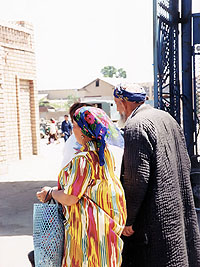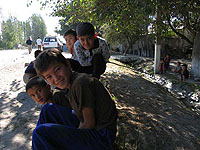 |
|
Uzbekistan - People |
|||
|
History of the Uzbek ethnicity. Uzbeks have a mixed anthropological origin. Uzbeks practice Islam, its Sunni branch. Historically, the Uzbek ethnicity has developed in Central Asia, between the two rivers (the Amu Darya and the Syr Darya ) along with the ancient natives of the region - Soghds, Bactrians, Sak-massagets, and other ethnic groups. Later, they were called by the single name "Uzbek". The traditional way of life of Uzbeks has historically been connected with farming, horticulture, craftsmanship, trade, and animal husbandry. Family relations and the distribution of labor were quite unique: generally, men were in charge of farming, gardening and craftsmanship; women took care of all the household activities including cooking, weaving, looking after domestic animals, and bringing up babies. In foothills and desert areas the animal husbandry was the main activity. Craftsmanship was the major type of work in cities. Skilled craftsmen made different products and items including silk, various textile and household materials. Daily activities of people had an impact on their cultural and social characteristics. National Uzbek clothes have also been developed according to climatic characteristics, as well as historical and ethnic- regional features. That is why, the dress attributes in southern regions are quite different from those in northern or eastern provinces. However, now it is usual for many Uzbeks to wear European style dress. During national ceremonies artists usually wear national dress. Traditional dress can be seen particularly in provinces, and village areas. Most women wear traditionally designed dresses made of national fabrics such as atlas, khonatlas, shoyi, and others. For men living in village areas the most popular attire is the chapan (robe) and doppy (head dress), embroidered with needlework. Uzbek national cuisine is very delicious. Popular national dishes - Attpilov (palov), lagmon, manti, kabab, shorva, and mastava. The most popular - palov made of rice, meat, oil, carrot, onion, and various spices. People eat a lot of fruit and vegetables. Besides fruits, there are different kinds of nuts, sweets, and cookies on the national Uzbek table. One cannot imagine Uzbeks' table without Uzbek style bread and the most appreciated drink - tea. There are number of different types of bread in different areas of the country. Uzbek language. Uzbek is a state language in Uzbekistan. It belongs to the Turkic language group. There are a lot of dialects in the country and it demonstrates the variety of ethnic groups, which formed the Uzbek nation. The formation of Uzbek literary language covers three historical periods: the ancient Turkic language, ancient Uzbek language, and contemporary Uzbek language. The great scholar and poet of the 15th century Alisher Navoi has significantly contributed to the development of the Uzbek language. The contemporary Uzbek language started to take shape in the beginning of the 20th century. There are three main dialects in the Uzbek language: karluk, kipchak, and oguz. Contemporary Uzbek language has developed upon the basis of dialects spoken in Tashkent and Ferghana. Uzbek people used the Arabic alphabet until 1927 and then - the Latin script from 1927 to 1938, In 1939 the Cyrillic alphabet came on the scene. In 1994 the Government of Uzbekistan decided to change the Uzbek alphabet into the Latin script again. This process will be completed in 2005. Thus, currently the Uzbek alphabet, based on the Latin script, has 26 letters and 3 letter combinations. The basics of Uzbek vocabulary are mainly composed of common Turkic as well as Uzbek words, which came on the scene based on the former. Uzbek also contains a significant number of international words. |

